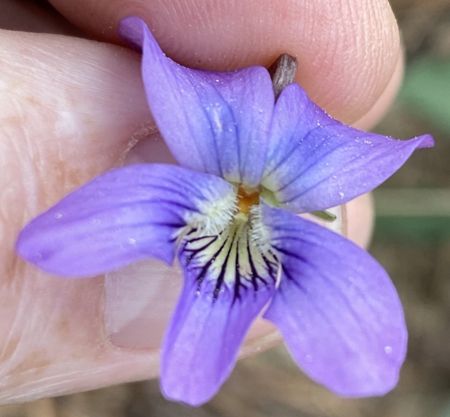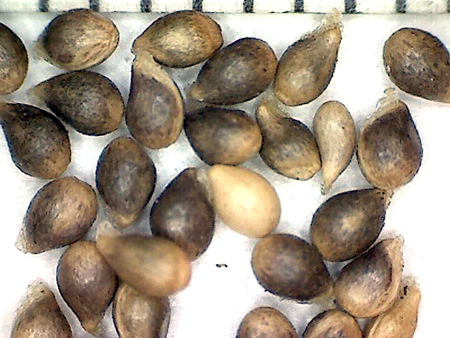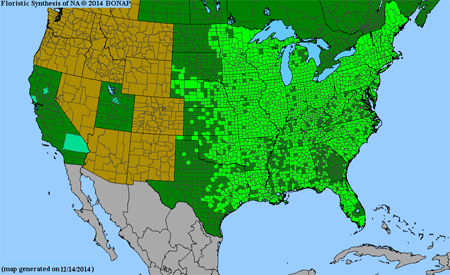Viola sororia [glabrous variant]
Common names:
None.
Synonyms:
Viola cucullata Aiton var. glaberrima Ging., in DC., Prodr. 1: 292. 1824. Type: "in hortis Europaeis culta" [protologue], 1809, M. Balbis s.n. (Type: G-DC G00208904 (n.v.), internet image).
Description:
Plant strictly glabrous, calyx eciliate; leaf blade outline ovate, apex mostly obtuse to rounded, eciliate; seeds 1.5–2.0 × 1.0–1.3 mm, light to medium gray or gray-brown with small prominent gray or gray-brown streaks. Other features same as the species complex.
Ecology:
Loam or clay soils in dry-mesic, mesic and wet-mesic forests, apparently similar to Viola sororia but needs further study.
Distribution:
Specimens and scattered uniform populations in NY, PA, VA and NC suggest a distribution in the Appalachian Mountains, adjacent uplands and Piedmont; specimens outside this distribution may represent uniform populations or single individuals in polymorphic V. sororia populations.
Rarity:
None.
Phenology:
Presumably same as the species complex.
Affinities:
Same as the species complex.
Hybrids:
Reports of hybrids involving "V. papilionacea" probably refer to this, V. communis, or Viola sororia [glabrous variant]. They include V. affinis (Brainerd 1904b, 1924), V. brittoniana (Brainerd 1924), V. cucullata (Brainerd 1906b), V. emarginata (Brainerd 1924), V. fimbriatula (Brainerd 1904b, 1906b, 1924), V. hirsutula (Brainerd 1907a, 1924, Henry 1953a), possibly V. nephrophylla (Brainerd 1924), V. palmata var. triloba (Brainerd 1912, 1924), V. pedatifida (Greene 1903a, Brainerd 1913a, 1924), V. sagittata (Brainerd 1906b, 1924), V. sororia sensu stricto (Brainerd 1924, Henry 1953a), V. stoneana (Brainerd 1912, 1924), and V. subsinuata sensu stricto (Dowell 1910, Brainerd 1912, Brainerd 1924). The actual parentage of these hybrids (with respect to which glabrous phenotype was actually involved) needs to be established beyond doubt. Brainerd reported that these exhibit intermediate or recombinant characteristics of foliage, chasmogamous flowers, cleistogamous capsules and seeds (where these did not abort). All hybrids fail to reproduce by chasmogamous flowers, and the cleistogamous capsules are abortive or produce a drastically diminished proportion of viable seeds.
Comments:
The brief protologue and type material of Viola cucullata Aiton var. glaberrima Ging. at the de Candolle Herbarium in Geneva appear to match this variant of V. sororia.
The present taxon is most similar to V. sororia sensu stricto but the foliage is strictly glabrous and does not usually turn yellow-green in later summer or fall, the leaf blades are typically more obtuse to rounded at apex and margins are more evenly crenate-serrate, and the seeds are paler overall. As uniform populations, this taxon appears to be more geographically restricted than V. sororia sensu stricto, in the Appalachian Mountains, uplands and Piedmont. The strictly glabrous foliage and eciliate sepals, and the paler seed pigmentation seen in some specimens, may represent a joint pleiotropic genetic effect.
Literature Cited:
Brainerd, E. 1904b. Notes on New England violets. Rhodora 6: 8-17.
Brainerd, E. 1906b. Hybridism in the genus Viola,-II. Rhodora 8: 6-10.
Brainerd, E. 1907a. Mendel’s law of dominance in the hybrids of Viola. Rhodora 9: 211-216.
Brainerd, E. 1912. Violet hybrids between species of the palmata group. Bulletin of the Torrey Botanical Club 39: 85-97.
Brainerd, E. 1913a. Four hybrids of Viola pedatifida. Bulletin of the Torrey Botanical Club 40: 249-260.
Brainerd, E. 1924. The natural violet hybrids of North America. Vermont Agricultural Experiment Station Bulletin 239: 1-205.
Dowell, P. 1910. The violets of Staten Island. Bulletin of the Torrey Botanical Club 37: 163-179.
Greene, E. L. 1903a. The genus Viola in Minnesota-I. Pittonia 5: 115-133.
Henry, L. K. 1953a. The Violaceae in western Pennsylvania. Castanea 18(2): 37-59.

Chasmogamous flowering habit (plant in NC, Durham) by Alan Weakley

Chasmogamous flower front view (plant in NC, Durham) by Alan Weakley

Seeds from a herbarium specimen: Transplanted from PA, Delaware Co., Kelly Drive, H. Ballard 15-025Z (BHO)

Seeds from a herbarium specimen: Transplanted from VA, Giles Co., Mountain Lake Road crossing with Appalachian Trail, plant Y, H. Ballard s.n. (BHO)

Map of the Viola sororia species complex by the Biota of North America Program